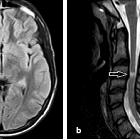Marburg variant of multiple sclerosis


The Marburg variant of multiple sclerosis, also known as acute, fulminant, or malignant multiple sclerosis, is characterized by extensive and fulminant acute demyelination, often resulting in death within one year after the onset of clinical signs.
Please, refer to the main multiple sclerosis (MS) article for a broad discussion on this entity.
Epidemiology
Marburg variant is typically seen in younger patients .
Clinical presentation
Symptoms may be preceded by fevers and are typically monophasic.
Pathology
Areas of demyelination demonstrate marked macrophage infiltration, marked associated inflammation, and extensive tissue destruction, necrosis and axonal damage and necrosis .
Unlike other multiple sclerosis variants, the peripheral nervous system may also be involved .
Radiographic features
As is the case with other demyelinating diseases, MRI is the modality of choice for assessing patients with suspected Marburg type multiple sclerosis.
MRI
Extensive confluent areas of tumefactive demyelination are seen with mass effect and defined rings and incomplete ring enhancement .
Only rarely are numerous smaller lesions seen disseminated throughout the brain .
Treatment and prognosis
Marburg type MS typically is rapidly progressive, fulminant and often results in death from involvement of the brain stem or due to marked mass effect and herniation .
Only rarely do affected areas remyelinate .
History and etymology
It was first described in 1906 by the Austrian neurologist Otto Marburg (1874-1948).
Differential diagnosis
Possible imaging differential considerations include:
- Baló concentric sclerosis (BCS)
- acute disseminated encephalomyelitis (ADEM)
- similar, although Marburg is usually more severe
Siehe auch:
und weiter:

 Assoziationen und Differentialdiagnosen zu acute malignant Marburg type:
Assoziationen und Differentialdiagnosen zu acute malignant Marburg type:

